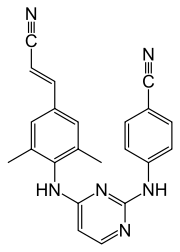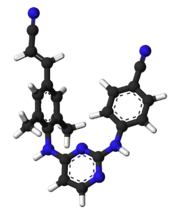Rilpivirine
Rilpivirine (TMC278, trade name Edurant) is a pharmaceutical drug, developed by Tibotec, for the treatment of HIV infection.[1][2] It is a second-generation non-nucleoside reverse transcriptase inhibitor (NNRTI) with higher potency, longer half-life and reduced side-effect profile compared with older NNRTIs, such as efavirenz.[3][4]
 | |
 | |
| Clinical data | |
|---|---|
| Trade names | Edurant |
| AHFS/Drugs.com | Consumer Drug Information |
| MedlinePlus | a611037 |
| License data |
|
| Pregnancy category |
|
| Routes of administration | Oral |
| ATC code | |
| Legal status | |
| Legal status |
|
| Pharmacokinetic data | |
| Elimination half-life | 38 hours |
| Identifiers | |
IUPAC name
| |
| CAS Number | |
| PubChem CID | |
| ChemSpider | |
| UNII | |
| KEGG | |
| ChEBI | |
| ChEMBL | |
| NIAID ChemDB | |
| PDB ligand | |
| CompTox Dashboard (EPA) | |
| ECHA InfoCard | 100.224.394 |
| Chemical and physical data | |
| Formula | C22H18N6 |
| Molar mass | 366.42 g/mol g·mol−1 |
InChI
| |
| | |
Rilpivirine entered phase III clinical trials in April 2008,[5][6] and was approved for use in the United States in May 2011 under the brand name Edurant.[7] A fixed-dose drug combining rilpivirine with emtricitabine and tenofovir disoproxil (TDF), was approved by the U.S. Food and Drug Administration in August 2011 under the brand name Complera;[8] it was licensed in the European Union under the brand name Eviplera in November 2011.[9]A newer fixed-dose drug also combining rilpivirine with emtricitabine and tenofovir alafenamide (TAF) was approved in March 2016 under the brand name Odefsey.[10]
Like etravirine, a second-generation NNRTI approved in 2008, rilpivirine is a diarylpyrimidine (DAPY). Rilpivirine in combination with emtricitabine and tenofovir has been shown to have higher rates of virologic failure than Atripla in patients with baseline HIV viral loads greater than 100,000 copies/mm3.
References
- "TMC278 — A new NNRTI". Tibotec. Archived from the original on 2008-12-20. Retrieved 2010-03-07.
- Stellbrink HJ (2007). "Antiviral drugs in the treatment of AIDS: what is in the pipeline?". Eur. J. Med. Res. 12 (9): 483–95. PMID 17933730.
- Goebel F, Yakovlev A, Pozniak AL, Vinogradova E, Boogaerts G, Hoetelmans R, de Béthune MP, Peeters M, Woodfall B (2006). "Short-term antiviral activity of TMC278—a novel NNRTI—in treatment-naive HIV-1-infected subjects". AIDS. 20 (13): 1721–6. doi:10.1097/01.aids.0000242818.65215.bd. PMID 16931936.
- Pozniak A, Morales-Ramirez J, Mohap L, et al. "48-Week Primary Analysis of Trial TMC278-C204: TMC278 Demonstrates Potent and Sustained Efficacy in ART-naïve Patients. Oral abstract 144LB". 14th Conference on Retroviruses and Opportunistic Infections. Archived from the original on October 19, 2007.
- "A Clinical Trial in Treatment naïve HIV-1 Patients Comparing TMC278 to Efavirenz in Combination With Tenofovir + Emtricitabine". ClinicalTrials.gov. National Institutes of Health. October 25, 2012. Retrieved January 1, 2014.
- "A Clinical Trial in Treatment naïve HIV-Subjects Patients Comparing TMC278 to Efavirenz in Combination With 2 Nucleoside/Nucleotide Reverse Transcriptase Inhibitors". ClinicalTrials.gov. National Institutes of Health. May 14, 2012. Retrieved January 1, 2014.
- "FDA approves new HIV treatment". U.S. Food and Drug Administration. Retrieved 2011-05-20. Edurant is approved for treatment-naive patients with a viral load of 100,000 copies/mL or less at therapy initiation. Its recommended dosage is 25 mg orally once daily with a meal, in combination with other antiretrovirals. It is contraindicated for use with proton pump inhibitors due to the increased gastric pH causing decreased rilpivirine plasma concentrations, potentially resulting in loss of virologic response and possible resistance. A
- "Approval of Complera: emtricitabine/rilpivirine/tenofovir DF fixed dose combination". U.S. Food and Drug Administration. August 10, 2011.
- "Eviplera". Aidsmap. Retrieved September 1, 2014.
- https://www.accessdata.fda.gov/drugsatfda_docs/label/2016/208351s000lbl.pdf